
SEED Starting
Everything You Need to Know
The rewards of seed starting are many—planting on your schedule, having a diversity of varieties to work with and experiencing the sheer joy of knowing that what you see on your dinner plate or in your vase was started by you and not the local garden center. Let us help you get off to a great start with seed starting tips, techniques and supplies.
What is seed starting?
Seed starting indoors is a simple and sometimes essential way to get a garden head start. Long-season vegetables and annual flowers often need extra growing time in early spring when the chilly outdoors are not an option.

When considering indoor growing options, remember that all seed starting kits are not created equal.
The basics of starting plants from seeds are quite simple: Place a seed or seeds in a soil-filled container; provide a light source, food and water; and allow the seeds to germinate. When grown, the seedlings can be planted in your garden.
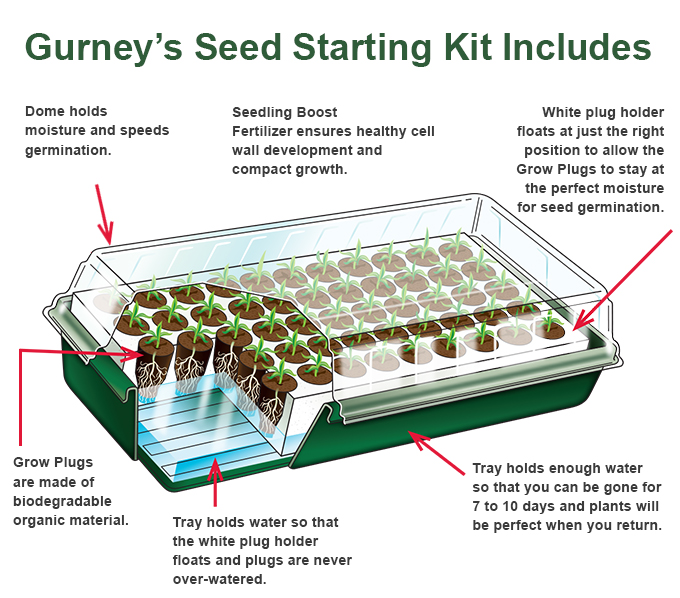

What seeds should I start with?
Many common garden vegetables and flowers can be started indoors. Some are very simple and easy. Tomatoes, peppers, cabbage, broccoli, eggplant and many more are well suited for starting indoors. Beans and peas are often recommended for direct sowing in the garden, but it never hurts to start a handful of them indoors in case the outdoors prove unforgiving. Think of it as your seed safety net. Usually these are ready to plant out within a month or less. They have very vigorous root systems that fill the cells quickly. Avoid starting root crops like turnips, beets and carrots indoors. Although some people may have been successful starting these in trays or pots, the likelihood of success is much less than for most non-root crops.
When should I start growing seeds?
When to start is based on when your plants can be planted in the garden safely. The timing for planting seeds varies depending on the type of crops. For example, plants like basil, peppers and tomatoes need to go in much later than cabbage, kale and broccoli. Seed packets often give instructions on timing, mostly described as weeks before planting out. It doesn't pay to start your seeds too early. This is true for several reasons. Plants can get too big for their pots or their growing space before you can safely plant them in the ground. Also, they dry out quickly, and keeping them watered is hard unless you keep repotting them.
Where should I grow seeds—indoors or outdoors?
Many seeds can be planted directly into the garden and perform wonderfully. Others, however, are much better suited to starting indoors to get a jump on the season. Starting seeds indoors puts you in better control of the conditions your plants will be growing in. It is often way too cold and wet early in the season when gardeners get the urge to start. Even when the weather warms, conditions can be challenging outside where small seedlings are vulnerable to the pressures of insects and diseases. Severe weather like late frosts and heavy rains can also impact young plants outside.
Use our Frost Dates Calculator to find the average dates of the last light freeze of spring and first light freeze of fall for locations across the U.S. Simply enter your ZIP or Postal code in the field above to see frost dates for your location (based on the nearest weather station), as well as the length of your growing season based on frost dates.
What is the best seed starting container?
Seed starting containers can vary widely, and no one container is best. In general, shallow containers or seed starting trays are more effective and easier to use for seed starting than deep containers. Most small seedlings do not need an overabundance of soil. Whatever container you choose, make sure it has drainage holes. If it doesn't, drill holes in the bottom. Waterlogged soil in a poorly drained container will cause many problems including rotted seeds and dead seedlings. Here are just a few options to consider:
-
Multi-Cell Kits
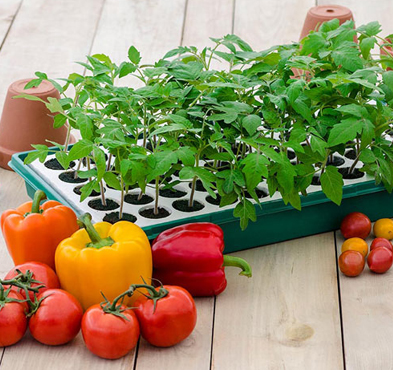
A multi-cell seed starting kit can grow dozens of starts in a compact space and comes with everything needed to germinate a lot of seeds quickly. Gurney's 55-cell kit includes a cell tray, water reservoir, soil plugs, fertilizer and a humidity dome and simple instructions for success.
-
Biodegradable Pots
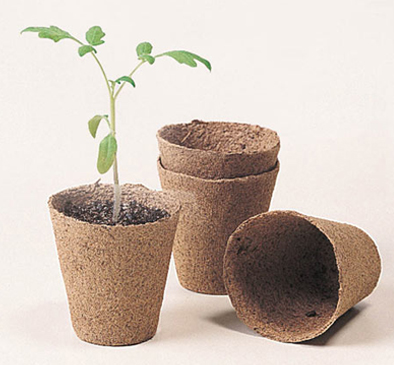
The perfect size for small seedlings, biodegradable pots allow you to transplant without disturbing the young plants growing inside, because you plant the whole pot directly into the garden. These convenient vessels are made of peat, newspaper or compost and will break down in the soil over time. A drainage tray will be needed for indoor watering.
-
Compressed Peat Pellets
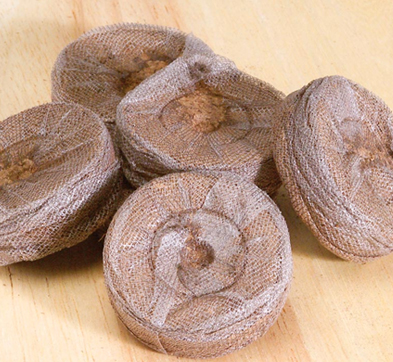
Expanding up to five times their original size when wet, peat pellets create an ideal substrate for seed germination, thanks to the highly absorbent and non-compacting nature of peat itself. To get started, arrange the pellets in a tray, add water to expand them and sow your seeds. When the seedlings are ready to transplant, the whole pellet, outer bag and all, can be planted in the garden.
What is the best seed starting soil?
Start with a soil blend specifically made for seed starting like Natural Beginnings™ Seed Starting Mix or the Seed Starting Fertilizer Mix. A seed starting mix should be very light and fine textured. Avoid bagged soil that contains pine chips, wood fiber or other chunky material that can prevent seeds from breaking through the soil blend. Also, never use garden soil. It doesn't drain well, is too heavy and can contain pests, diseases and weed seeds. Avoid reusing potting soil since it can contain soilborne diseases. It's well worth the extra effort to start with a good quality mix. A strong start can carry over to better garden performance.
Keep in mind that you should moisten the soil before or after putting it in your containers. Many people pre-moisten in a separate container. This is especially helpful if the soil mix has become extremely dry and can't readily absorb water.
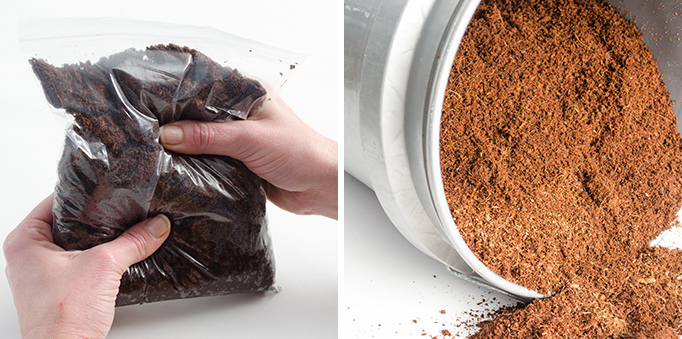
What are the temperature considerations for germinating seeds?
The best temperature at which to plant seeds depends on the type of crops you're planting:
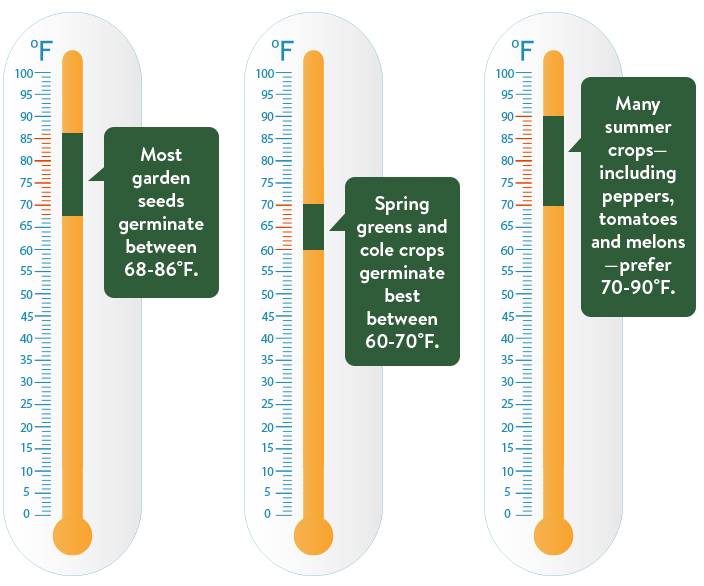
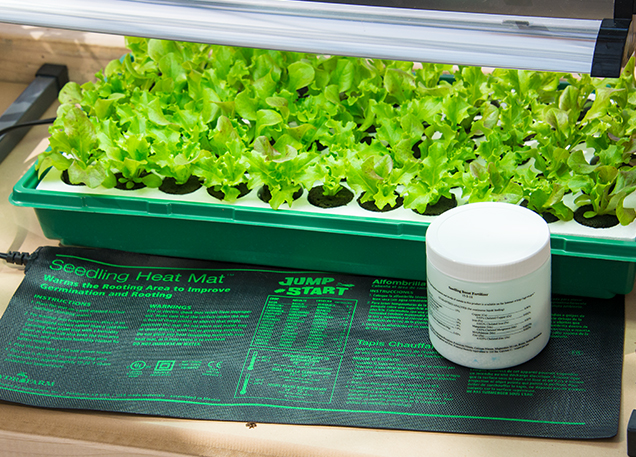
A Seedling Starter Heat Mat provides a good way of keeping a consistently warm soil temp. Simply place your containers on the heat mat until the seeds have germinated and are well established. Once established, the plants can be moved off the heat mat as long as the ambient temperature is warm.
Seed Starting: Step-by-Step Guide for Germinating Seeds
Wondering how to germinate seeds indoors? Continue reading on to learn our step-by-step process for how you can start your garden and easily grow plants and vegetables from seed to harvest!
1 Gather the supplies you'll need
 Supplies needed for starting your own seeds indoors can be very basic. At the very least you will need soil,
a light source and containers. However, there are many items that are very useful and can have a positive effect on seedling germination and growth: soil blended just for seed propagation, a seed starting kit, heat mats and adjustable grow lights, to name a few.
Supplies needed for starting your own seeds indoors can be very basic. At the very least you will need soil,
a light source and containers. However, there are many items that are very useful and can have a positive effect on seedling germination and growth: soil blended just for seed propagation, a seed starting kit, heat mats and adjustable grow lights, to name a few.
2 Prepare the soil
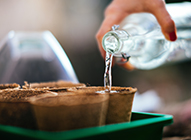 Prior to planting seeds, moisten the potting soil. This can be done by placing soil in the containers you are using and then watering, or moistening the soil in a bucket or tub before filling the containers. When potting soil gets dry, it can become hydrophobic, meaning it won't absorb water. The tub or bucket method works great for this. You may need to let the soil rest and hydrate for a little while after you add water.
Prior to planting seeds, moisten the potting soil. This can be done by placing soil in the containers you are using and then watering, or moistening the soil in a bucket or tub before filling the containers. When potting soil gets dry, it can become hydrophobic, meaning it won't absorb water. The tub or bucket method works great for this. You may need to let the soil rest and hydrate for a little while after you add water.
Watch Seed Starting Video
Watch Seed Starting Video
3 Plant the seeds
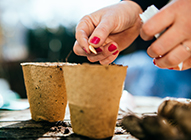 When growing plants from seed, always check the packet or seed catalog for planting instructions before you plant. Planting depth varies. Some plants can be sown 1 inch deep whereas others are sown on the soil surface. Start by making a small divot the depth suggested on the seed packet. Carefully drop the seed in the divot. If more than one drops in, don't worry; you can thin to one plant later. When seeding plug trays or small cell packs, it's okay to have two or more seedlings germinate in the same cell. For many vegetables, especially greens, after planting in the garden you can harvest one a little early and let the other plant reach maturity. After seeding trays or containers, cover the seed divot and seed with additional potting soil and gently water in using a misting bottle or a watering can with a very fine shower.
When growing plants from seed, always check the packet or seed catalog for planting instructions before you plant. Planting depth varies. Some plants can be sown 1 inch deep whereas others are sown on the soil surface. Start by making a small divot the depth suggested on the seed packet. Carefully drop the seed in the divot. If more than one drops in, don't worry; you can thin to one plant later. When seeding plug trays or small cell packs, it's okay to have two or more seedlings germinate in the same cell. For many vegetables, especially greens, after planting in the garden you can harvest one a little early and let the other plant reach maturity. After seeding trays or containers, cover the seed divot and seed with additional potting soil and gently water in using a misting bottle or a watering can with a very fine shower.
4 Water and feed the seedlings
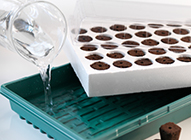 Watering is one of the key tasks to perform once the seeds are sown. As plants grow, allow the soil to dry slightly between waterings. It's best to use a misting bottle or a sprinkling can that creates a fine shower. Course, heavy streams of water can wash out seeds and damage fragile seedlings.
Use a water-soluble plant food according to directions on the fertilizer package. If no rate is given for seedlings, cut the rate in half or quarters for initial feedings. When plants become more established, the regular rate can be used.
Watering is one of the key tasks to perform once the seeds are sown. As plants grow, allow the soil to dry slightly between waterings. It's best to use a misting bottle or a sprinkling can that creates a fine shower. Course, heavy streams of water can wash out seeds and damage fragile seedlings.
Use a water-soluble plant food according to directions on the fertilizer package. If no rate is given for seedlings, cut the rate in half or quarters for initial feedings. When plants become more established, the regular rate can be used.
5 Provide light
 Bright light is key to growing strong and healthy plants. It doesn't matter whether you're using a grow light or a windowsill, strong, bright light is critical. When using grow light, you need to be able to raise the light fixture or the plant platform so that as the seedlings grow, the light is within 4 inches of the top of the plants.
For windowsills, rotate seedlings daily since they will grow towards the light and lean. About 14-16 hours of light per day is ideal. Your grow light can be plugged into an inexpensive timer to control light hours.
Bright light is key to growing strong and healthy plants. It doesn't matter whether you're using a grow light or a windowsill, strong, bright light is critical. When using grow light, you need to be able to raise the light fixture or the plant platform so that as the seedlings grow, the light is within 4 inches of the top of the plants.
For windowsills, rotate seedlings daily since they will grow towards the light and lean. About 14-16 hours of light per day is ideal. Your grow light can be plugged into an inexpensive timer to control light hours.
6 Provide bottom heat
 Providing a heat source below your containers is a good way to increase germination. Peppers are well known for their need of warm soil to germinate. Bottom heat can be achieved by several means. The easiest is the use of a heat mat like Gurney's Seedling Starter Heat Mat. Place the mat under your containers and plug it in.
If you have a multitiered light stand, the upper levels can be used for germination since the lights below will heat up the flats above them. Some people even put the containers on top of a water heater until germination occurs and then quickly position them under lights so they don't get spindly from lack of light.
Providing a heat source below your containers is a good way to increase germination. Peppers are well known for their need of warm soil to germinate. Bottom heat can be achieved by several means. The easiest is the use of a heat mat like Gurney's Seedling Starter Heat Mat. Place the mat under your containers and plug it in.
If you have a multitiered light stand, the upper levels can be used for germination since the lights below will heat up the flats above them. Some people even put the containers on top of a water heater until germination occurs and then quickly position them under lights so they don't get spindly from lack of light.
7 Keep the air moving
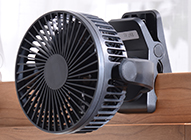 Air circulation is a wonderful tool to aid your seed starting efforts. A gentle breeze helps prevent disease, promote stronger plants, control fungus gnats and keep algae from growing on the soil surface. Position a fan so that air flows over the seedlings. This keeps air flowing without blowing the seedlings down.
If you are growing multiple flats of plants, an oscillating fan is a good way to cover a large area.
Air circulation is a wonderful tool to aid your seed starting efforts. A gentle breeze helps prevent disease, promote stronger plants, control fungus gnats and keep algae from growing on the soil surface. Position a fan so that air flows over the seedlings. This keeps air flowing without blowing the seedlings down.
If you are growing multiple flats of plants, an oscillating fan is a good way to cover a large area.
8 Move outdoors
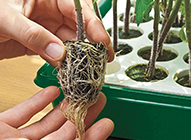 Eventually, your plants will need to be moved outside to harden off. Hardening off is the process of acclimating young plants to outdoor growing conditions. If you were to plant outdoors without hardening off, the seedlings would get sunburned and possibly die. The process should be gradual.
First move the seedlings to a bright, but shaded spot outside that is protected from the wind. Bring them in at night. After a few days, slowly start exposing them to direct sunlight and wind. The process should take a week, and then they will be able to withstand the elements of outdoor growing.
Eventually, your plants will need to be moved outside to harden off. Hardening off is the process of acclimating young plants to outdoor growing conditions. If you were to plant outdoors without hardening off, the seedlings would get sunburned and possibly die. The process should be gradual.
First move the seedlings to a bright, but shaded spot outside that is protected from the wind. Bring them in at night. After a few days, slowly start exposing them to direct sunlight and wind. The process should take a week, and then they will be able to withstand the elements of outdoor growing.
9 Transplant seedlings
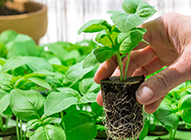 It may be necessary to transplant seedlings while they are still growing inside. When multiple seeds are sown in the same container, they should be gently taken out and planted into individual pots or cells. This should be done when the plants get their first or second set of true leaves. Be very careful when handling the young plants. The roots, stems and leaves are very fragile at this stage.
Plants sown and growing in individual plugs or cell packs may also need transplanting if they get root-bound. It is critical to follow seed packet directions about timing to avoid having to transplant.
It may be necessary to transplant seedlings while they are still growing inside. When multiple seeds are sown in the same container, they should be gently taken out and planted into individual pots or cells. This should be done when the plants get their first or second set of true leaves. Be very careful when handling the young plants. The roots, stems and leaves are very fragile at this stage.
Plants sown and growing in individual plugs or cell packs may also need transplanting if they get root-bound. It is critical to follow seed packet directions about timing to avoid having to transplant.
Seed Starting Troubleshooting
What are these small insects flying around my pots, and should I be concerned?
The most likely suspects are fungus gnats. Fungus gnats are small flies that can be found in and around containerized plants and potting soil, especially indoors and in greenhouses. Their larvae feed on organic matter in potting soil and sometimes feed on plant roots. Besides being a nuisance, they can damage your seedlings. They thrive in wet soil, so allow soil to dry between waterings. A gentle breeze from a small fan will help keep them from landing and laying eggs. It will also help keep them out of your houseplants. Houseplants are often a source of fungus gnats, so make sure you get these pests under control before your seedlings emerge. Any Bt product listed for mosquitos can be sprinkled on the soil surface of seedling containers and houseplants to help control insect populations. Yellow sticky traps like Pot Stickers - Insect Glue Trap are very effective at catching gnats and flies.
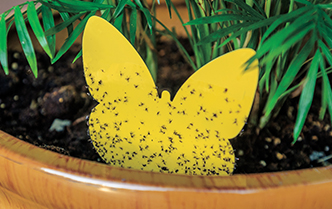
My seedlings collapsed and died.
When seedlings collapse and die soon after germinating the main culprit is a disease called Damping Off, which is caused by several different fungal species. To help prevent this from affecting your seedlings, start with new seed starting soil mix. Do not reuse old potting mixes or use garden soil as these can carry the disease. Cold, wet soil should be avoided. Use a heat mat to warm the soil, and make sure your containers drain properly so the soil won't get waterlogged. It's also a good idea to start with clean pots. Dipping them in a mild bleach solution kills off any fungal spores or pathogens.
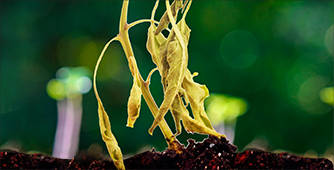
My plants are tall and spindly. What should I do?
Make sure your grow light is very close to the tops of your plants. You don't want them reaching for light. Plus, light level is lower when the source of light is farther away. Also make sure your plants are getting enough light. They need at least 14 hours a day. Excessive warmth can cause spindly plants, too. Try lowering the heat in the area where they are growing. Finally, air movement from a small fan will make the plants sturdier.
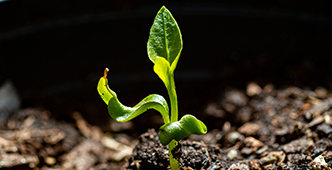
My seedlings have a purple cast on their leaves. What's wrong?
A purple cast on the leaves and purple leaf veins indicate a phosphorus deficiency. When seedlings are young and their root systems are not well developed, they often have trouble taking up enough phosphorus to prevent deficiencies. To remedy this, feed your plants with a water-soluble fertilizer. If you have been doing this at low doses and they are still purple, increase the rate. However, never exceed the recommended rate on the package. Do not use full strength the first time you fertilize because this may burn the seedlings.

Why didn't my seeds germinate better?
Your seeds could have been planted too deep. Some seeds need to be exposed to light and are sown on top of the soil; if covered, they won't germinate. Before sowing seeds always check the seed starting instructions or look up each plant variety online. Some seeds need warmer soil temperatures to germinate. Peppers are very sensitive to low temps. Soil too wet can rot seeds, and soil too dry can inhibit germination.
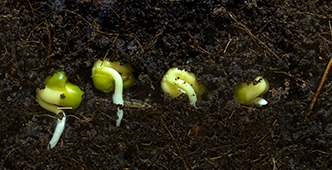
My plants keep wilting.
Plants that have vigorous top growth but are root-bound will wilt soon after watering. Once watered, they recover until the soil dries again. If this continues, the plants will need to be transplanted into a larger container or planted outside, weather permitting. One other solution is to put a saucer under them to hold a little water. This will help them stay hydrated longer.
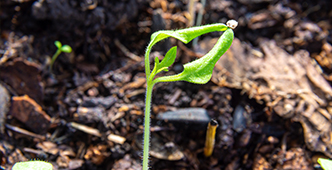

Starting your own seed is a rewarding hobby. Picking that first tomato is much more meaningful when you have nurtured it from seed to fruit. The selection of flowers and vegetables to grow from seed is vast. We hope the steps outlined above will start you on a long path of seed starting.





 Gardens Alive! & Supplies
Gardens Alive! & Supplies






